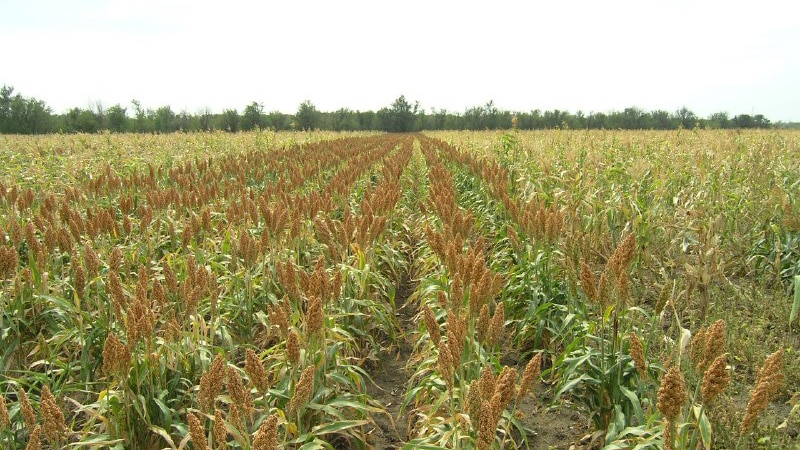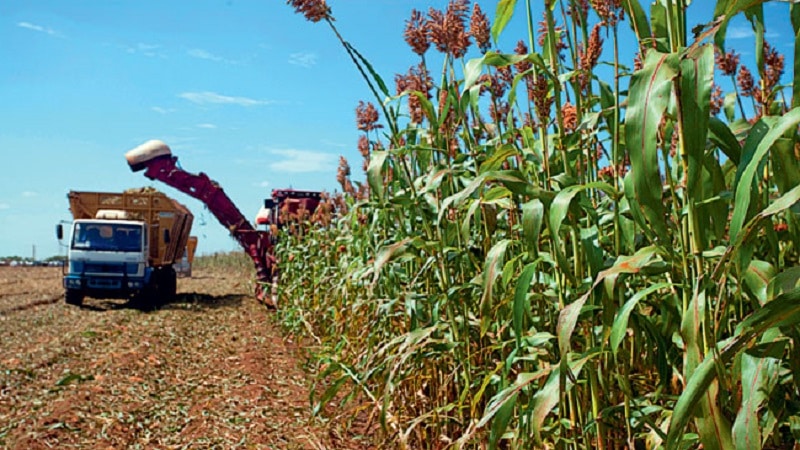What is grain sorghum, features of its use and cultivation
Grain sorghum is one of the oldest grains. Today it is one of the five most popular plants in the world, and more and more farmers are paying close attention to it. Culture deserves special attention from land owners, especially those located in the southern, arid regions.
What is grain sorghum
Sorghum – a multi-purpose crop. Three main types are most widespread: grain, broom and sugar. The plant is familiar to most ordinary people as a raw material. for making traditional brooms.
Meanwhile, crop cultivation is becoming more widespread.
Grain varieties are those grown for the purpose of producing grain.
The ability to easily tolerate heat and dry weather is due to the uniqueness of the plant’s root system - it is very powerful and developed, it is capable of quickly absorbing a significant volume of water. Stem height – from 50 cm to 1.5 m.
At the stage of 5-6 leaves, new shoots appear on the sprout, and at 7-8, the growth of the stem accelerates significantly until the formation and emergence of a panicle. The flowering time of the plant is 7-10 days.

The grain is round, sometimes slightly ovoid, bare or membranous, easily shed. The weight of a thousand seeds is from 20 to 30 g. From 1600 to 3500 grains are formed in a panicle. Food grades are usually white grain, there is no tannin taste.
It is possible to sow sorghum using the dotted method with row spacing of 60-70 cm, then the seed cost for sowing will be 10-14 kg per 1 hectare. When planting, you can also use the square-nest method according to the 70x70cm pattern, when four to six seeds are placed in a nest; then the consumption is reduced to 6-10 kg per 1 hectare.
Important! When calculating the required number of sorghum seeds, you need to take into account their field germination. After all, laboratory germination is usually very high and can reach 95%, while real field germination is only 19%.
Growing technology
Cultivation technology requires careful soil preparation before planting, including leveling the soil surface, removing weeds and ensuring optimal soil moisture. Sorghum is not demanding on soil: light, heavy, and saline varieties are suitable. In this case, the most suitable soil is moist, loose, sufficiently heated and aerated. In early spring, before sowing, one or two plowings and harrowing are carried out.

Soil enrichment
Sorghum is very demanding when it comes to feeding. It responds best to the application of fertilizers under the plowed soil:
- The plant needs nitrogen during the period of intensive growth and for the formation of leaf mass;
- phosphorus – as a regulator of metabolic processes during the period of root formation, flowering and fruiting;
- potassium promotes the appearance of sugar.
The use of nitrogen fertilizers simultaneously with phosphorus fertilizers has a bad effect on the viability and germination of seeds. Fertilizing must be applied separately and also deeper than the seeds. With this method of care, yields can increase up to three times.
When preparing the soil for sowing, manure is also used.It is optimal to plant it in the fall or during pre-sowing preparation in the spring, placing it locally and deeply, slightly away from the sowing site.
Important! You should not exceed the standards of mineral fertilizers recommended by manufacturers; this may cause the accumulation of toxic substances in the grain.
Seed treatment
Before sowing, seed preparation begins several weeks before sowing. They are treated in advance to protect the plant from infection by fungal and bacterial infections and to destroy pathogenic microflora, which has a very negative effect on plant growth. It is better to choose a combination preparation for dressing, for example, “Fentiuram”, which also helps against soil pests.
Today, popular preparations are used to treat seeds using a semi-dry method. To do this, for 1 ton of seeds take 5-10 liters of water, 1.5-2 kg of combined disinfectant, 150 g of soluble glass.
Important! It has been scientifically proven that treating seeds before sowing increases germination from 46% to 67%.
Optimal sowing time
The time for sorghum sowing occurs when the average soil temperature per day at a depth of 10 cm reaches +14...+16°C. At this temperature regime, crops appear in approximately two weeks, when the temperature rises to +25°C and above - earlier than in a week.
Important! Planting sorghum in unheated soil is not allowed. In this case, the seeds will rot, will not germinate and will become overgrown with weeds.
Sowing method
Among spring crops, sorghum has the smallest seeds, which vary significantly in weight among different varieties. To find out the seeding weight rate, you need to take into account the density of plants per hectare and the width between rows, especially for bushy varieties.The sowing rate is on average 10-14 kg per 1 hectare, which is 160-170 thousand plants.
When calculating the norm, one should take into account not laboratory, but field germination, which is several times lower.
The soil should be moist when sowing; the seeds should not be planted deep. When deep sowing of small sorghum seeds increases the germination period, the plants become weak and unstable to adverse weather conditions.
Seeding depth:
- 7 cm – optimal in favorable weather conditions;
- 10-12 cm – if the top layer of soil is too dry;
- 4 cm - on irrigated lands or if the soil is very wet.
A high harvest can be harvested with a fairly small width between the rows - 50-70 cm, since in such conditions the plant is better provided with nutrition.
Crop care

This stage consists of several sequential activities:
- Rolling the soil with special ring rollers, resulting in the formation of a mulch layer.
- Five days after sowing, harrowing is carried out to eliminate weeds.
- If after sowing the cold returns, and after 10 days the crops have not grown more than 2-3 cm, harrow again. During the first harrowing, weeds are destroyed by 60%, during the second - by 85%.
- If a crust has formed on the surface of the soil, it must be loosened so that it does not interfere with the emergence of seedlings. Before the sprouts emerge, harrowing is carried out; if germination has already occurred, the crust is removed with rotary hoes.
- Subsequently, the row spacing is treated with cultivators. This involves loosening, maintaining soil moisture, aerating the soil, destroying pest larvae and simultaneously applying fertilizer.
Weed control, pest and disease protection
The most dangerous weeds are bristleweeds.During the period of sorghum germination, this plant is easily destroyed by harrowing. Subsequently, the weed becomes resistant to such treatment and resistant to some herbicides. Chemical treatment with the preparations “Agritox”, “2.4D”, “2M-4X” will help to destroy it.
Sorghum is quite resistant to pests and diseases. Sometimes crops do suffer and are eaten by pests such as aphids, meadow borers, bollworms, wireworms and false wireworms. They cause significant damage to crops, devouring young foliage, stems and grain. To combat insects, treatment with insecticides “Operkot”, “Zenith”, “Bi-58” is used.
Important! Processing is carried out in strict accordance with the instructions while observing all safety standards.
In the event of a massive invasion of larvae, crops are sprayed with biological products “Dendrobacillin” and “Lipidocid”.
Despite its relative resistance, sorghum is sometimes affected by diseases such as leaf spot, rust, smut, stem rot, helminthosporiosis, fusarium and alternaria, which significantly reduce yield.
To prevent infection, you need to promptly eliminate plant debris, disinfect the soil, and treat the seeds before planting.
Harvest

Harvesting of sorghum begins in September when it reaches full ripeness and the required humidity, which should not be higher than 25-30%.
Harvesting is carried out by direct combining using a conventional grain harvester for harvesting small-seeded crops. In this case, the revolutions are reduced to 500-600 per minute to prevent grain crushing.
The threshed grain is immediately cleaned of plant residues, dried if necessary and stored.
Attention! You should not postpone harvesting sorghum until October in the hope that its moisture content will decrease during this time. Possible re-accumulation of liquid and deterioration in grain quality.
Applications of grain sorghum
Application area grain crops are now very extensive.
In animal husbandry
Sorghum is included in food concentrates used in feeding pigs, cows, horses and poultry. The nutritional value of grain sorghum is superior to corn in terms of protein and is equivalent to barley. At the same time, the yield of sorghum is higher than that of barley, so from one hectare of sorghum you can get twice as much pork as from 1 hectare of barley.
The composition of sorghum grains includes up to 15% protein, about 70% starch and 4% fat. Sorghum is successfully used in fattening pigs and livestock; its total percentage in feed should reach up to 50%.
In poultry farming
Sorghum grain contains four times more potassium, 1.5 times more calcium and 1.3 times more magnesium than corn grain. The listed microelements contribute to the formation of the shell and bones. As a result, when feeding sorghum, poultry productivity can increase by up to 30%.
In fish farming
The use of sorghum in an amount of 20% of the total mass in the composition of feed for feeding pond fish can significantly increase the production and catch of live fish. The use of sorghum in the process of fish breeding increases the profitability, while the nutritional value of sorghum feed is not inferior to feed from cereal crops.
Reference. The introduction of sorghum into the carp diet reduces feed consumption by up to 50%.
In the alcohol industry
Sorghum grain contains up to 74% of the starch necessary for ethanol production.It has a significantly higher yield compared to other grain crops (sorghum - 60-100 c/ha, corn - 50-60 c/ha) used in the production of alcohol.
Thus, there is a significant reduction in the cost of manufactured products.
Sorghum beer
Beer made from sorghum tastes practically no different from barley beer, while its cost is 85% cheaper. It has an original velvety taste and an unusual pleasant smell.
In the food industry

Sorghum grain has high nutritional value, contains proteins, a lot of fiber, as well as iron, vitamin B6 and other useful substances.
Cereal sorghum, created by modern breeders, has great potential for use in human nutrition. This new grain crop contains substances necessary for a healthy diet. It can be used to prepare cereals, soups, side dishes, puddings, etc.
Sorghum starch is increasingly used in the food industry because it does not have the unpleasant taste associated with corn starch.
Pigments from sorghum husks are used as dyes in the food industry.
The highest quality wax is produced from the hulls of sorghum grains.
Conclusion
In constantly changing agroclimatic conditions, it can be difficult to obtain a full harvest from traditional grain crops. Under these conditions, it is important to grow plants that optimally use moisture, tolerate drought well, and do not require large expenses for fertilizers. Sorghum is just such a crop.